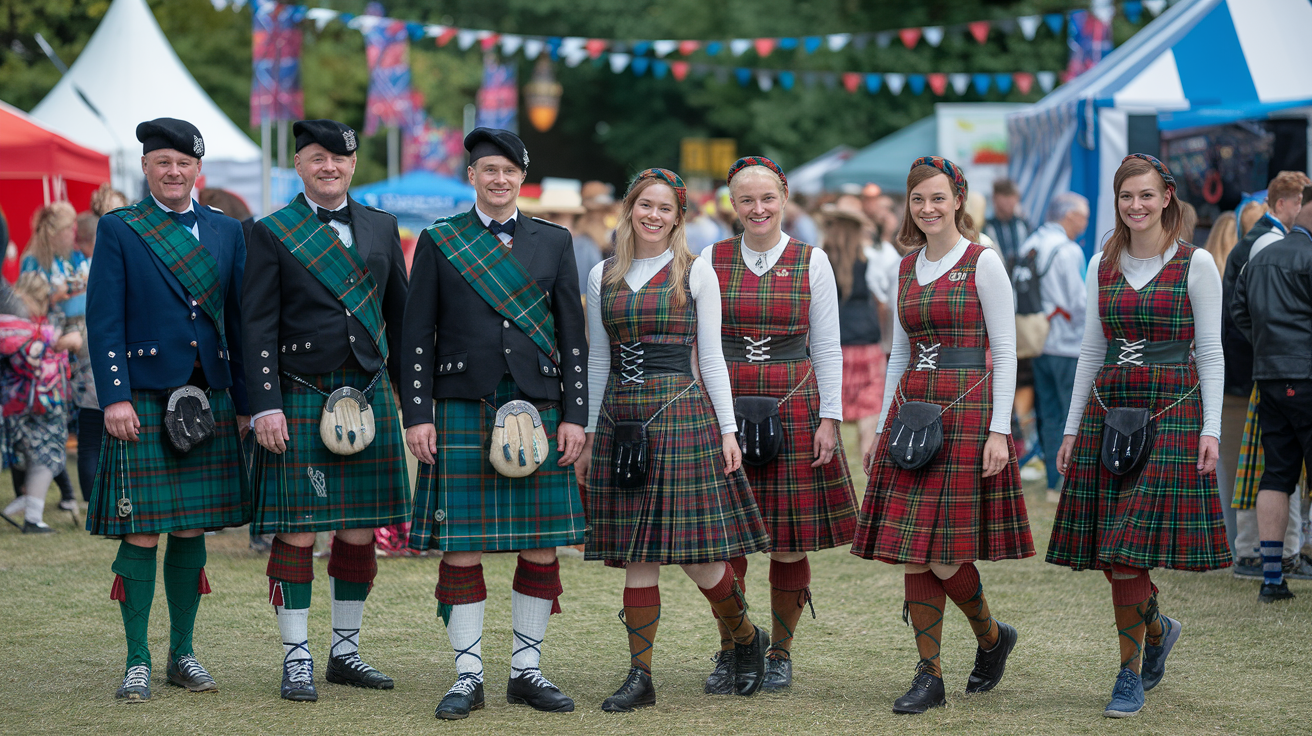
March 27, 2025
Scottish Tartan Clothing: Embracing the Heritage of Scotland in 2025
Scottish tartan clothing is more than just fabric—it is a timeless symbol of Scottish heritage, tradition, and pride. Tartan has been worn for centuries, representing Scottish clans, regional identities, and even personal fashion choices. Whether you are drawn to tartan for its historical significance, its vibrant patterns, or its deep connection to Scotland’s past, incorporating it into your wardrobe is a wonderful way to honor this rich tradition.
From kilts to scarves, tartan clothing comes in many forms, making it easy to wear for both special occasions and everyday life. In this article, we will explore the history of tartan, different types of tartan clothing, how to choose the right tartan, and where to buy authentic Scottish attire.
The History of Tartan
The origins of tartan date back over 2,000 years, with evidence of early woven tartan fabrics found in Scotland and other parts of Europe. However, tartan became widely recognized in the 16th and 17th centuries as a defining symbol of Scottish identity.
Each Scottish clan developed its unique tartan pattern, distinguished by specific colors and weaves. These patterns allowed individuals to identify members of their clan, fostering a sense of unity and pride. However, after the Jacobite uprisings in the 18th century, the British government banned the wearing of tartan through the Dress Act of 1746, as part of efforts to suppress Highland culture. This ban lasted for 36 years, but tartan never disappeared.
By the 19th century, tartan experienced a revival, particularly when Queen Victoria and Prince Albert embraced it as a symbol of Scotland. Today, tartan remains a beloved pattern, worn by Scots, Scottish descendants, and fashion enthusiasts worldwide.
Types of Scottish Tartan Clothing
Scottish tartan can be worn in a variety of ways, from traditional Highland dress to modern fashion. Here are some of the most popular types of tartan clothing:
1. Kilts
The kilt is the most iconic piece of Scottish clothing. Traditionally worn by men, kilts are pleated garments that wrap around the waist and are secured with a belt. They are often paired with:
1-A sporran (a small pouch worn at the front)
2-Knee-high socks and garters
3-A kilt pin for decoration
4-A Prince Charlie jacket for formal occasions
Today, kilts are worn for weddings, Scottish festivals, Highland games, and other ceremonial events. There are also modern variations such as utility kilts, designed for everyday wear.
2. Tartan Trews
Tartan trews are close-fitting trousers traditionally worn by Highlanders before kilts became popular. Trews are a stylish and practical alternative to kilts and are often worn at formal events or as part of Scottish military dress.
3. Tartan Skirts and Dresses
For women, tartan skirts and dresses provide a beautiful way to incorporate Scottish heritage into fashion. Styles range from classic pleated skirts to elegant, flowing tartan dresses suitable for special occasions.
4. Tartan Shawls and Scarves
A tartan shawl or scarf is a great way to wear tartan subtly while adding warmth and style to an outfit. These accessories are versatile and can be draped over the shoulders, wrapped around the neck, or used as a head covering.
5. Tartan Jackets and Waistcoats
Tartan jackets and waistcoats (vests) add a sophisticated touch to formal or semi-formal attire. These are often worn with kilts or tartan trews for a complete Scottish look.
6. Tartan Accessories
If you want to embrace tartan without wearing a full garment, tartan accessories such as:
Ties and bow ties
1-Handbags and purses
2-Hats and gloves
3-Socks and shoes
These subtle additions allow you to incorporate tartan into your outfit with ease.
How to Choose the Right Tartan
When selecting a tartan, you have several options based on your personal preference or heritage:
Clan Tartans – If you have Scottish ancestry, you may want to wear the tartan associated with your family’s surname. Many tartan databases can help you find the right one.
Regional Tartans – If you don’t have a clan tartan, you can choose a tartan representing a specific region of Scotland.
Universal Tartans – Some tartans, such as Black Watch, Royal Stewart, and Hunting Stewart, can be worn by anyone, regardless of ancestry.
Fashion Tartans – Many designers create tartan patterns that are not linked to any specific clan, allowing anyone to wear them as a fashion choice.
Where to Buy Authentic Scottish Tartan Clothing
To ensure you are purchasing genuine Scottish tartan, consider buying from reputable retailers:
Tartan Trov
Tartan Trov is a top choice for authentic Scottish tartan clothing, offering a wide range of kilts, skirts, shawls, and accessories. Known for high-quality craftsmanship and traditional designs, Tartan Trov provides both classic and modern tartan styles to suit every occasion.
Scottish Kilt Makers and Tailors
Many traditional shops in Scotland, particularly in Edinburgh, Glasgow, and the Highlands, offer high-quality kilts and tartan garments. These stores are renowned for their skilled craftsmanship and use of authentic Scottish wool.
Online Tartan Specialists
Websites such as The Scotland Kilt Company, Heritage of Scotland, and Tartan Weaving Mill provide a vast selection of tartan clothing and accessories. They cater to both traditional and modern styles, with international shipping options available.
Custom Tailors
For a personalized touch, some companies offer custom-made kilts and tartan suits, allowing you to select your preferred tartan pattern and style. This is a great option for those looking for a perfect fit and unique design.
FAQs About Scottish Tartan Clothing
Conclusion
Scottish tartan clothing is a powerful way to connect with Scotland’s heritage, whether you wear it to honor your ancestry, celebrate Scottish culture, or simply embrace a timeless fashion trend. From kilts and trews to scarves and accessories, tartan allows you to showcase Scottish pride in a way that suits your style.
No matter which tartan you choose, wearing it proudly keeps the spirit of Scotland alive for generations to come.




